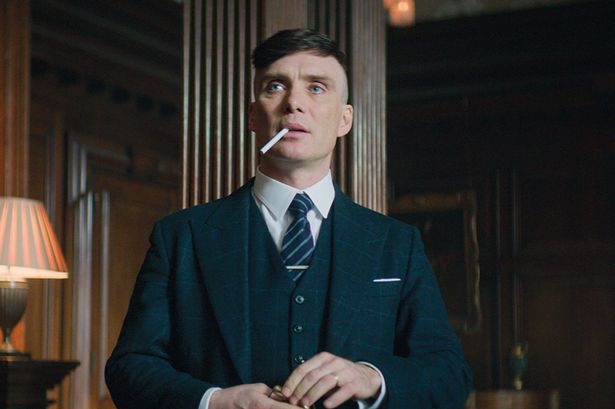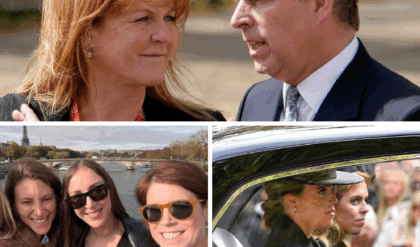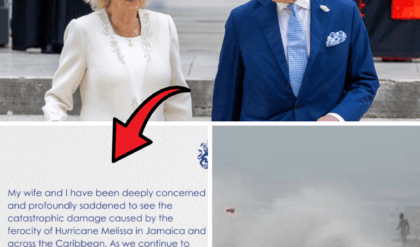In the mist-shrouded corners of Britain’s coastal underbelly, where the sea whispers secrets to the wind and fog clings to the cobblestones like a guilty conscience, a new guardian of the night has emerged. “Ashes in the Fog,” an eight-part British noir thriller that premiered last month on BBC One, marks the electrifying collision of two of television’s most compelling forces: the unflinching Nicola Walker as Detective Chief Inspector Rowan Ellis and the brooding Cillian Murphy as the enigmatic crime novelist Eamon Doyle. This series isn’t just another whodunit—it’s a labyrinthine descent into the fragile boundary between page and peril, where stories don’t just mimic life; they devour it.
From the outset, “Ashes in the Fog” grips viewers with a premise as chilling as a North Sea gale. DCI Rowan Ellis, a battle-hardened investigator haunted by her own unresolved losses, is thrust into a series of vanishings plaguing the fictional harbor town of Greyhaven—a stand-in for the grim, rain-lashed ports of northern England. Young women, each with a fleeting connection to the literary world, disappear without a trace, leaving behind cryptic notes scrawled in ink that smells faintly of salt and regret. As Ellis pores over the evidence, her path inexorably leads to Eamon Doyle, Greyhaven’s reclusive literary darling whose bestselling novels have long toyed with the macabre. Doyle’s tales of spectral abductions and vengeful ghosts mirror the crimes with uncanny precision. Is he a prophet of darkness, or the architect of it? As the investigation deepens, Ellis finds herself ensnared not just in Doyle’s web of words, but in a psychological maelstrom that blurs her grip on sanity, forcing her to question whether the killer is hiding in the shadows—or scripted within the pages of Doyle’s unpublished manuscript.
What elevates “Ashes in the Fog” beyond the standard procedural is its masterful fusion of atmospheric dread and intellectual cat-and-mouse. Created by emerging screenwriter Lila Hargrove, whose debut short film won accolades at the Edinburgh International Television Festival, the series draws on the rich vein of British noir traditions while carving out its own jagged niche. Hargrove, inspired by her childhood summers in the fog-bound fishing villages of Cornwall, crafts a narrative that pulses with the isolation of remote locales. Filming took place over six grueling months in 2024, primarily along the rugged cliffs of St Ives and the derelict docks of Liverpool’s Albert Dock, where the production team battled relentless Atlantic storms to capture the elemental fury that mirrors the characters’ inner turmoil. The creaking lighthouse at Godrevy, a hulking sentinel battered by waves, serves as the story’s nerve center—a place where Ellis confronts Doyle in a finale that feels less like a resolution and more like a fever dream.
At the heart of this tempest are Walker and Murphy, whose chemistry crackles with the tension of two souls circling a shared abyss. Nicola Walker, the London-born actress who has become synonymous with portraying women on the precipice of emotional collapse, imbues Rowan Ellis with a quiet ferocity that lingers long after the credits roll. Born in 1970 in the working-class enclave of Stepney, Walker cut her teeth on the stages of the Cambridge Footlights before exploding onto television in the late 1990s. Her breakthrough came with the espionage thriller “Spooks,” where she played the sharp-witted analyst Ruth Evershed, a role that showcased her knack for conveying vulnerability beneath steely resolve. Over the years, Walker has amassed a pantheon of unforgettable characters: the grieving mother in “Last Tango in Halifax,” the dogged cold-case detective in “Unforgotten,” and most recently, the wry marine biologist turned cop in “Annika.” Yet Ellis represents a departure—a woman whose pursuit of justice is laced with personal ghosts. “Rowan isn’t your typical hard-boiled detective,” Walker shared during a set visit in Liverpool, her voice carrying the soft lilt of her East End roots. “She’s unraveling from the start, piecing together a puzzle that’s as much about her own fractured past as it is about these missing lives. Playing her felt like walking a tightrope over the fog— one wrong step, and you’re lost.”

Walker’s preparation for the role was as methodical as Ellis’s investigations. She spent weeks immersing herself in the archives of real-life missing persons cases from Britain’s coastal regions, poring over yellowed police reports and faded photographs of fog-enshrouded harbors. This research lent an authenticity to her performance that borders on the visceral; in one harrowing episode, Ellis sifts through a victim’s abandoned flat, her fingers trembling as she uncovers a half-read copy of Doyle’s latest novel, its pages marked with frantic underlines. Walker’s eyes, those piercing blue-grey windows to the soul, betray a dawning horror that needs no dialogue to convey. It’s a masterclass in restraint, a reminder of why Walker has earned a reputation as one of Britain’s most understated powerhouses. Off-screen, she’s the antithesis of her intense roles: a devoted mother to her two children with actor Barnaby Kay, and an advocate for mental health awareness in the arts, often speaking candidly about the toll of embodying trauma night after night.
Enter Cillian Murphy as Eamon Doyle, and the series ignites into something truly incendiary. The Irish actor, whose piercing gaze has haunted screens since his breakout in 2002’s “28 Days Later,” brings a serpentine charisma to the novelist that teeters on the edge of malevolence. Born in 1976 in the pastoral outskirts of Cork, Murphy grew up in a family steeped in education—his father a civil servant, his mother a French teacher—yet he rebelled early, trading textbooks for theater spotlights. His early career was a whirlwind of indie darlings and genre gems: the ghostly innocent in “The Girl with All the Gifts,” the calculating mobster Thomas Shelby in “Peaky Blinders,” and the tormented physicist J. Robert Oppenheimer in Christopher Nolan’s 2023 Oscar-sweeping biopic. Murphy’s win for Best Actor at the Academy Awards that year catapulted him to global icon status, but it was his ability to embody quiet menace that drew producers to him for “Ashes in the Fog.” Doyle is no cartoonish villain; he’s a man whose intellect is his sharpest weapon, a writer whose insomnia-fueled prose has made him a cult figure among Greyhaven’s literati. “Eamon lives in the gray,” Murphy explained in a rare interview from his Dublin home, his voice a soft brogue laced with introspection. “He’s not evil—he’s addicted to the thrill of creation, the way a story can twist reality until you can’t tell where one ends and the other begins. Channeling that was liberating, almost dangerous. I’d write pages of ‘Doyle’s diary’ entries myself between takes, just to get inside his head.”
Murphy’s commitment extended to the physical: he shed 15 pounds for the role, adopting Doyle’s gaunt, hollow-cheeked silhouette through a regimen of sea swims in the icy Cornish waters and sparse, fish-heavy meals evocative of the novelist’s ascetic lifestyle. On set, his interactions with Walker were a study in contrasts—her grounded intensity clashing against his ethereal detachment, sparking scenes that director Elena Voss, a veteran of “Broadchurch” and “The Capture,” described as “electric alchemy.” Voss, whose lens has long favored the interplay of light and shadow, amplifies the duo’s dynamic through innovative cinematography. Low-angle shots from the harbor’s underbelly make Doyle loom like a specter, while Walker’s Ellis is often framed against vast, indifferent seascapes, underscoring her isolation. The score, a haunting blend of cello drones and distant foghorns composed by rising star Aoife O’Donovan, weaves through episodes like smoke, heightening the sense of encroaching doom.
As the series unfolds across its taut eight hours, “Ashes in the Fog” peels back layers of deception with surgical precision. Episode one introduces the first disappearance: a budding poet last seen reciting verses at a dimly lit harbor tavern, her scarf tangled in the pilings like a noose. Ellis, fresh from a botched case that cost her a partner’s life, arrives in Greyhaven with the weight of command but none of its comfort. Her team—a cynical sergeant with a drinking problem and a tech-savvy rookie harboring secrets of her own—provides able support, but it’s Doyle who dominates the narrative’s undercurrents. By the third installment, parallels between his novels and the crimes become impossible to ignore: a victim found with ashes in her pockets, echoing a ritual from Doyle’s “Whispers from the Deep”; a lighthouse beam flickering in Morse code, spelling out phrases from his unpublished sequel. Hargrove’s script toys with unreliable narration, intercutting Ellis’s interrogations with dreamlike sequences from Doyle’s perspective—blurry visions of ink bleeding into seawater, pages tearing like flesh.
Thematically, the series probes the seductive peril of storytelling itself. In a culture obsessed with true crime podcasts and fictionalized atrocities, “Ashes in the Fog” asks: What happens when the artist becomes the avatar of his own horrors? Doyle’s arc, revealed in fragmented flashbacks to his youth in a storm-ravaged Irish coastal town, suggests a man scarred by loss, channeling grief into gothic prose that now threatens to consume him. Ellis, meanwhile, grapples with her own narrative— a failed marriage, a daughter estranged by her mother’s obsessions—mirroring the novelist’s isolation. It’s this emotional parity that makes their confrontations so riveting; in episode six, a rain-soaked standoff atop the lighthouse sees Doyle murmur, “Stories don’t lie, Inspector—they wait,” a line delivered by Murphy with such silken menace that it sends chills racing down the spine.
Critics have hailed “Ashes in the Fog” as a worthy successor to the pantheon of British noir greats. Like “Broadchurch,” with its intimate dissection of community fractures, or “Luther,” Idris Elba’s descent into moral ambiguity, it thrives on psychological depth over procedural flash. Yet where “Happy Valley” barrels forward with Sarah Lancashire’s unyielding fury, this series lingers in the liminal spaces—the fog that obscures as much as it reveals, the pauses heavy with unspoken accusations. Viewership numbers surged to 8.2 million for the premiere, outpacing even the finale of “Vigil,” and social media buzz has been relentless, with fans dissecting clues on forums and theorizing Doyle’s guilt (or innocence?) in viral threads.
For Walker and Murphy, the project represents a pinnacle of creative risk. Walker, who turned 55 during filming, spoke of the role’s physical demands—chase scenes along slick harbor walls, nights spent in draughty lighthouse interiors—as a rejuvenating challenge. “At this stage, I crave stories that scare me,” she admitted. Murphy, ever the private enigma, found solace in Doyle’s complexity, a counterpoint to the bombastic energy of his recent blockbusters. “After Oppenheimer, I wanted something intimate, where the explosions are all internal,” he reflected.
As the fog lifts on season one’s cliffhanger—Ellis discovering a final manuscript page that implicates her own past—the anticipation builds for what’s next. Will the BBC greenlight a second outing? Whispers from the production camp suggest yes, with Hargrove already outlining arcs that plunge deeper into Doyle’s fractured psyche. In a landscape of glossy imports and formulaic fare, “Ashes in the Fog” stands as a beacon: proof that British television’s darkest alleys still yield the most luminous gems. Tune in, if you dare—but beware: once the mist rolls in, it never truly clears. In Greyhaven, every ending is just the shadow of another beginning.





